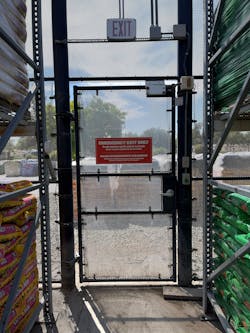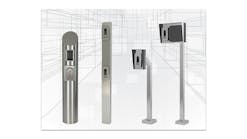Delayed-egress systems are special locking arrangements that are subject to codes, standards, the discretion of the local authority having jurisdiction (AHJ) and federal requirements. These devices play a critical role in life safety and the security of occupants, with installation requirements tied closely to the occupancy of the facility, its use and other characteristics.
The governing codes pertaining to electronic controlled doors include the International Code Council’s International Building Code (IBC) and International Fire Code (IFC), as well as the National Fire Protection Association (NFPA) 101 Life Safety Code, among others.
Delayed-egress requirements can change according to the code cycle — every three years. With the most recent printings — IBC 2015, 2018 and 2021— delayed egress has evolved based on real-world applications, and installers should take note. These nuances affect occupancy and classification and provide allowances and modifications that potentially open the technology to new applications. A good understanding of delayed egress is essential.
What’s delayed egress?
Maglocks, either as part of a component-designed system or a stand-alone configuration, use electronics to create a delay in egress at specific doors. These electronic door-control systems allow passage after a specified period — 15 or 30 seconds, depending on the time allowed on the system permit approved by the AHJ. Delayed-egress systems also might be configured with access control systems and always are integrated with the on-site fire-protection system whether it’s sprinklers or fire-, smoke- or heat-detection systems.
When a fire alarm or loss of power happens, doors unlock and immediate egress is allowed. Other requirements, such as emergency lighting and appropriate or approved signage that indicates the course of action for egress, also must be followed. Delayed-egress doors unlocked by a component of fire-protection system activation must remain unlocked until the fire-alarm system has been returned to normal operational function. Delayed-egress systems also always must be reset “manually.” Nuisance delays, which provide an audible signal near the door, range from 1 to 3 seconds.
Delayed egress can be made up of single or multiple components, but jurisdictions are moving in favor of single, listed systems. In fact, Denver was one of the first jurisdictions that passed a standard that states that the components for a delayed-egress lock “shall be listed as a complete assembly and individual, listed component may not be field assembled to build a delayed egress locking assembly.”
It's important to remember that controlled egress and delayed egress aren’t the same. Controlled egress is limited in application and applies to occupancy groups that are listed under Institutional (I-1 and I-2). These include assisted-living facilities, hospitals and mental healthcare facilities. (Locksmith Ledger will have more to say about controlled egress in an upcoming issue.)
Delayed egress enjoys much broader application. In recent years, it has become more flexible in use because of changes in the codes that make it easier to spec and apply to additional types of occupancies. The codes also provide allowances for modifications granted by the AHJ on an individual basis. This also might include the use of alternative materials, designs or a method of construction.
Code Considerations
Important considerations and starting points in delayed egress include:
- What ICC code series (year) is adopted in your area?
- Do you have a good understanding of the codes, including any amendments or written policies?
- What’s the occupancy type, and how is a given area being used?
- What’s the load, and what egress hardware is planned for the space?
The most common delayed-egress code in use is the 2018 version of IBC, but it also could be 2012, 2015 and 2021. Delayed egress can be found in Chapter 10, Section 10. (1010.1.9.7).
Two primary considerations in delayed egress are occupancy type and load. Occupancy type refers to how an area within a building will be used. The load pertains to the number of individuals who will egress from a building. A building could have an occupancy type of Assembly, Business or Educational, among other possibilities. (See “Occupancy Types.”)
Subgroupings further define the use of the space. For example, Assembly groupings include movie theaters (1); food and drink establishments (2); community halls (3); arenas (4); and stadiums (5). NOTE: A facility might have multiple occupancies, and delayed egress never permitted is in H-High Hazard applications.
Occupancy and load play a role in the hardware selected for any opening in a path of egress, and a site survey will determine the occupancy and subgroups.
Historically, and as part of the IBC 2012 and 2015 codes, delayed egress was allowed in any occupancy except Assembly, Educational and High Hazard. IBC 2018 expanded where delayed-egress systems could be applied and identified where delayed-egress systems could be installed. For example, when delayed egress is applied in public facilities (other than institutional), such as mercantile, residential and businesses, the hardware generally is installed at the following locations:
- Side or back door of a business
- Side or back door of a store
- Side or back door of a college building that has no Group A sections
- Side or back doors in an apartment building
Previous versions of IBC told us where delayed egress could NOT be applied. IBC 2018 also expanded the application of delayed egress to educational rooms that have an occupancy load of under 50 and into courtrooms (A-3 occupancy) for doors other than the rear primary entrance doors.
In addition, in the 2012 code, egress attempts would trigger an irreversible alarm process after 1 second of continuous force. The 2015 and later codes permit 3 seconds of continuous force before the process becomes irreversible. NOTE: Many AHJ’s, however, are going back to the 1-second nuisance alarm. In any event, regardless of your area, always consult your local AHJ before any installation.
Doubling Up
Changes also have occurred in allowing occupants to pass through more than one delayed-egress locking system. In the 2015 code, a building occupant couldn’t pass through more than one delayed-egress system before they reach an exit. IBC 2015 included an exception for I-2 or I-3 occupancies. There, the egress path can include up to two delayed-egress solutions provided the total delay doesn’t exceed 30 seconds.
IBC 2018 expanded the exceptions to include I-1 and I-4 occupancies. These also might have up to two delayed-egress locking systems along the path of egress for a total delay of no more than 30 seconds as long as the building is equipped with an automatic sprinkler system.
In the 2021 code, the path of egress as written in 2018 is maintained, with two more conditions:
- Condition 1 - Buildings in which all people who receive custodial care who, without any assistance, can respond to an emergency to complete building evacuation.
- Condition 2 - Buildings in which any people who receive custodial care who require limited verbal or physical assistance while responding to an emergency to complete building evacuation.
Those two conditions if met also will allow for two delayed-egress solutions along the path of egress.
With regards to signage, an exception in 2018 and continued in 2021 code states: “Where approved, in Group 1 occupancies, the installation of a sign is not required where care recipients require restraint or containment as part of the function of the treatment area.”
Remember that a code official can make and grant modifications based on individual situations, particularly if there are practical difficulties in carrying out the provisions of the code. These also might include alternative materials, design and methods of construction and equipment. If you receive an approved variance, make sure you have written documentation of this allowance from your AHJ.
The codes are changing as they apply to delayed egress, occupancies and groupings. These nuances are important to understand, because they can affect your next delayed-egress installation and even open your specifications to new markets.
Rodger Schmidt, CAI, AFDI, is an ASSA ABLOY technical product trainer. He can be reached at [email protected].
Occupancy Types
The 11 primary occupancy types:
A-Assembly
B-Business
E-Educational
F-Factory and Industrial
H-High Hazard
I-Institutional
L-Laboratories (California)
M-Mercantile
R-Residential
S-Storage
Utility/Miscellaneous
For more information, go to www.iccsafe.org or www.nfpa.org.






